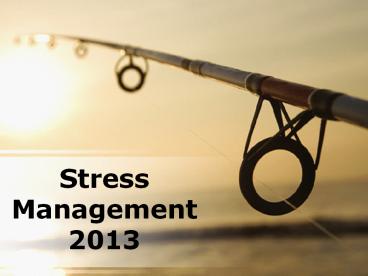Stress Management Powerpoint Content - PowerPoint PPT Presentation
Title:
Stress Management Powerpoint Content
Description:
ReadySetPresent (Stress Management PowerPoint Presentation Content): 100+ PowerPoint presentation content s. Stress management starts with identifying the sources of stress in your life. This isn’t as easy as it sounds and it may seem like there is nothing you can do about your stress level. However, you have more control than you might think. – PowerPoint PPT presentation
Number of Views:5110
Title: Stress Management Powerpoint Content
1
Stress Management2013
2
Biological Reactions to Stress
3
Program Objectives (1 of 3)
- Recognize stress and its symptoms.
- Diagnose personal and organizational
stress/stressors. - Identify specific problems and apply treatments.
- Gain practical techniques that can be readily
applied.
4
Program Objectives (2 of 3)
- Describe long- and short-term stressors and
trigger situations. - Identify your personal and work-related sources
of stress. - Describe several common lifestyle and societal
pressures that can produce stress.
5
Program Objectives (3 of 3)
- Reduce negative stress and its effects.
- Learn passive progressive relaxation techniques.
- Practice, discuss, and problem solve.
6
Definition
- Non-specific response to a demand -- a product of
change. - Any situation, good or bad, that causes you to
readjust.
7
The Alarm Reaction
- Biological changes.
- Increased gland activity.
- Increased heart and respiration.
- Elevated blood pressure.
- Body poised for action.
- Fight or Flight Response.
8
Stressors
- Physical -- external factors.
- Social -- caused by interactions between an
individual and his/her environment. - Psychological -- strong emotions can be brought
on by external or internal factors.
9
Kinds Of Stress
- The kind of stimulus that represents a challenge
or threat which causes an alarm reaction and then
elicits a response which resolves the situation. - A condition in which we experience a continual
barrage of unresolved stimuli.
10
Kinds Of Stress
- Appraisal Stage
- The first opportunity in which a person's belief
systems, past experience, and personality
determine if a specific situation will be
successful. - Coping Stage
- The second opportunity where the person
determines whether the response will be either
positive or negative.
11
Related Terms
- Anxiety.
- Free-Floating Anxiety.
- Stress.
- Tension.
- Fear.
- Phobia.
- Unconscious Anxiety.
- Panic.
- Existential Anxiety.
12
Standard Stress Response
13
Standard Stress Response (1 of 2)
- Increased blood pressure.
- Increased pulse rate.
- A heart-pounding feeling in your chest.
- Dilation of the pupils.
- Dry mouth.
14
Standard Stress Response (2 of 2)
- Increased perspiration, especially on the palms.
- Muscle tension.
- Fast, shallow breathing.
- Fatigue.
- Boredom.
15
Reaction To Stress
- The General Adaptation Syndrome, developed by
Hans Selye, former professor and director of the
Institute of Experimental Medicine and Surgery at
the University of Montreal, (Selye, 1974). - Stage 1 Alarm.
- Stage 2 Resistance.
- Stage 3 Exhaustion.
16
Negative Results Of Stress
17
Detecting Type A Behaviors
18
Organizational Sources Of Burn-Out
19
- Download Stress Management
- PowerPoint presentation
- at ReadySetPresent.com170 slides include 10
general stress facts, 14 stress reducers, 6
points on the alarm reaction, 3 points on
stressors, 6 points on kinds of stress, 9 related
terms, 10 points on standard stress responses, 7
biological reactions to stress, 15 points on
reaction to stress, 3 points on sleep
deprivation, 11 points on the way stress builds,
20 points on neustress, 20 points on eustress, 22
points on distress, 20 negative results of
stress, 14 positive results of stress, 13 points
on productivity curves, 13 defense mechanisms, 6
points on worries, 5 point system to tackle a
stressor, 9 personal signs and symptoms, 11
personal sources of burn out, 10 individual
strategies to minimize burnout, 12 points on
detecting Type A behaviors, 12 points on what to
do about Type As, 10 organizational sources of
burn out, 8 organizational signs and symptoms, 5
points on identifying the signals, 5 points on
clarifying expectations, 7 points on controlling
your workload, 7 skills for people pressures, 15
tips on workplace change, 4 points on balancing
your world, 10 points on organizational factors,
7 points on workplace stress, 3 results of
workplace stress, 14 points on helping others, 9
points on preparing for stress, 16 points on
coping with stress, 5 points on making an
itinerary, 13 anti-stress activities, 4 points on
exercise as a stress release, 5 steps, 5 allies
of stress, 4 adversaries of stress, 32 tension
words and cues, 32 relaxation words and cues, 16
points on PPR and 16 action steps and much more!
- Royalty Free - Use Them Over and Over Again.
- Updated Expanded 2013
- Now more content, graphics, and diagrams

